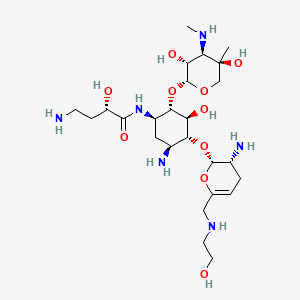Drug Information
Drug (ID: DG00173) and It's Reported Resistant Information
| Name |
Plazomicin
|
||||
|---|---|---|---|---|---|
| Synonyms |
ACHN-490; UNII-LYO9XZ250J; 1154757-24-0; LYO9XZ250J; Plazomicin [USAN:INN]; Plazomicin (USAN); ZINC68150640; DB12615; D10151; D-Streptamine,
Click to Show/Hide
|
||||
| Indication |
In total 4 Indication(s)
|
||||
| Structure |

|
||||
| Drug Resistance Disease(s) |
Disease(s) with Clinically Reported Resistance for This Drug
(2 diseases)
[3]
|
||||
| Target | Mitochondrial rRNA methyltransferase 2 (MRM2) | MRM2_HUMAN | [1] | ||
| Click to Show/Hide the Molecular Information and External Link(s) of This Drug | |||||
| Formula |
C25H48N6O10
|
||||
| IsoSMILES |
C[C@@]1(CO[C@@H]([C@@H]([C@H]1NC)O)O[C@H]2[C@@H](C[C@@H]([C@H]([C@@H]2O)O[C@@H]3[C@@H](CC=C(O3)CNCCO)N)N)NC(=O)[C@H](CCN)O)O
|
||||
| InChI |
1S/C25H48N6O10/c1-25(37)11-38-24(18(35)21(25)29-2)41-20-15(31-22(36)16(33)5-6-26)9-14(28)19(17(20)34)40-23-13(27)4-3-12(39-23)10-30-7-8-32/h3,13-21,23-24,29-30,32-35,37H,4-11,26-28H2,1-2H3,(H,31,36)/t13-,14+,15-,16+,17+,18-,19-,20+,21-,23-,24-,25+/m1/s1
|
||||
| InChIKey |
IYDYFVUFSPQPPV-PEXOCOHZSA-N
|
||||
| PubChem CID | |||||
| TTD Drug ID | |||||
| INTEDE ID | |||||
| DrugBank ID | |||||
Type(s) of Resistant Mechanism of This Drug
Drug Resistance Data Categorized by Their Corresponding Diseases
ICD-01: Infectious/parasitic diseases
| Drug Resistance Data Categorized by Their Corresponding Mechanisms | ||||
|
|
||||
| Key Molecule: Bifunctional AAC/APH (AAC/APH) | [1], [2] | |||
| Molecule Alteration | Expression | Up-regulation |
||
| Resistant Disease | Bacterial infection [ICD-11: 1A00-1C4Z] | |||
| Experimental Note | Identified from the Human Clinical Data | |||
| In Vitro Model | Staphylococcus aureus ATCC 29213 | 1280 | ||
| Staphylococcus aureus isolates | 1280 | |||
| Experiment for Molecule Alteration |
Whole genome sequence assay | |||
| Mechanism Description | AAC(6')-APH(2") is an enzyme with 6'-N-acetyltransferase and 2"-O-phosphotransferase activities.The bifunctional AAC(6')-APH(2") has the capacity to inactivate virtually all clinically important aminoglycosides through N- and O-acetylation and phosphorylation of hydroxyl groups. | |||
| Drug Resistance Data Categorized by Their Corresponding Mechanisms | ||||
|
|
||||
| Key Molecule: Aminoglycoside phosphotransferase (APH) | [3] | |||
| Molecule Alteration | Expression | Inherence |
||
| Resistant Disease | Enterococcus faecium meningitis [ICD-11: 1D01.2] | |||
| Experimental Note | Identified from the Human Clinical Data | |||
| In Vitro Model | Enterococcus faecium SF11770 | 1352 | ||
| Escherichia coli kHE5-2a | 562 | |||
| Escherichia coli strain DH10b(pMW119) | 316385 | |||
| Experiment for Molecule Alteration |
PCR | |||
| Mechanism Description | High-level gentamicin resistance (MIC >= 500 ug/ml) in enterococci is predominantly mediated by aac(6')-Ie-aph(2")-Ia, which encodes the bifunctional aminoglycoside-modifying enzyme AAC(6')-APH(2"). Found less commonly is aph(2")-Id, another gene recently reported to be associated with high-level gentamicin resistance in enterococci. | |||
References
If you find any error in data or bug in web service, please kindly report it to Dr. Sun and Dr. Zhang.
